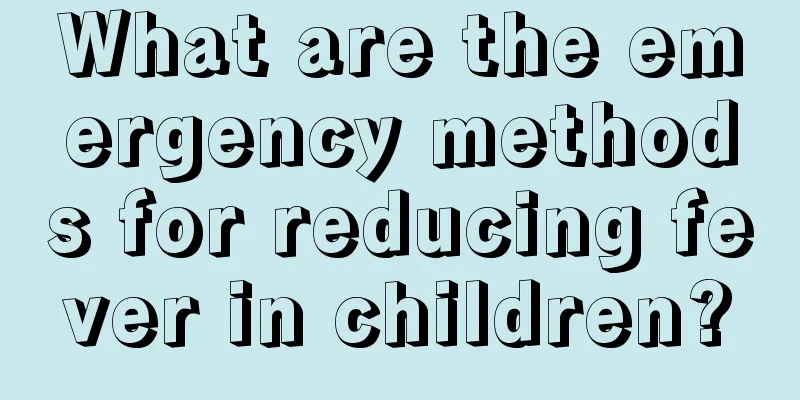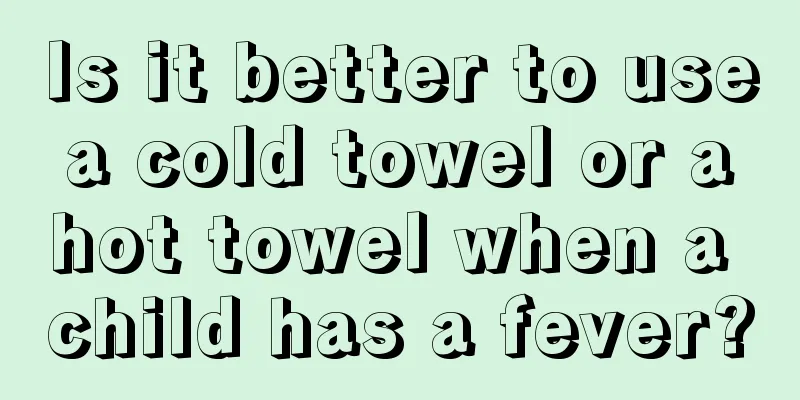What are the emergency methods for reducing fever in children?

|
Colds are a common problem among children. Once a child has a fever, mothers often become anxious, especially new mothers who are at a loss as to what to do. Fever can be mild or severe. Severe cases may cause fainting or even be life-threatening, so as parents, we must always pay attention to our baby's health. If your baby has a fever, you can use some acupoint massage to reduce the fever, or you can use cooling methods to reduce the fever, but these are only auxiliary. It is best to go to the hospital for examination and treatment. Ask the child to stretch out his hand with the palm facing up, and the adult uses the middle finger and index finger to gently push the inside of the child's arm from point A to point B. (You can use some massage oil or facial cream for lubrication) Do not use too much force to avoid hurting the baby's skin. Use about the same force as you would normally give a child. Do not push in the opposite direction. Repeat this method 200 times. This method is called Qingtianhe Water, and it is the most basic fever-reducing massage method. Ask the child to stretch out his hand with the palm facing up. The adult uses the middle finger and index finger to gently push from point C to point D on the thumb side of the child's arm. The force should be the same as in the first step of Qingtianhe Water, but not too great to avoid hurting the child's skin. Do not push in the opposite direction. Repeat this method 200 times. This method is called pushing three levels. Ask the child to stretch out his hand with the palm facing up. The adult uses the middle finger and index finger to gently push on the little finger side of the child's arm from point E to point F. As with the previous two steps, the force should not be too great to avoid hurting the child's skin. Do not push in the opposite direction. Repeat this method 200 times. This method is called retreat six The following step is very important. The location is the same as the first step of clearing Tianhe water, but the technique is different. Let the child stretch out his hand with the palm facing up, and the adult uses the middle finger and index finger to dip in warm water. Especially in winter, the water should not be too cold or too hot, warm is best. From point A to point B, gently pat your child's arms and blow air through your mouth while patting. The intensity is the same as in the above three steps. The whole process is like a horse crossing a river, clatter, clatter, do it 100 times. This method is called "crossing the river on a horse". After completing the above four steps, the child's body temperature will generally drop slowly in about half an hour to an hour. The above steps are for low fever below 38.5 degrees. If the fever is higher, but not exceeding 39.5 degrees, we will first complete the above steps of Qing Tianhe Shui, Tui Sanguan, Tui Liufu, and Da Ma Guo He, and then let the child lie on the bed with his back exposed, and be careful not to catch a cold. The adult uses the palm of his hand to push down from the child's cervical vertebrae to the coccyx, as shown from point G to point H in the figure. The force should be slightly greater than in the above steps. Push 10 times. If the fever exceeds 40 degrees, especially in the middle of the night when there is nothing you can do to reduce the fever, you can use emergency cooling method - ear bleeding. First, rub the highest part of the child's earlobe to relax the blood vessels there to reduce pain and help with bloodletting. Then pinch the tip of the ear with your left hand (pinching can also reduce pain) and prick it with a needle to let two drops of blood. The needle needs to be disinfected with alcohol before use. However, this method is actually rarely used, especially for young children with diabetes or blood diseases. Also, not everyone can get the needle in the right position. In addition, there is the issue of needle disinfection, which poses a risk of infection. Precautions If the above methods fail to reduce the temperature, it is best to go to the hospital to avoid delaying the treatment. Generally, when I have a low fever, I will use massage to reduce the fever first. If you have a high fever, especially one above 39 degrees, you should seek medical attention first. After all, a fever cannot be reduced simply by reducing it, the cause must be found and cured first. For high fever, massage is only an auxiliary method. |
<<: What to do if your child has oral herpes and a fever
>>: Why does a 2-year-old baby drool while sleeping?
Recommend
What to do if your child has a muscle strain
Many children are very naughty, so they are likel...
How to treat flat warts in children
We all know that flat warts mostly occur in teena...
What should I do if my baby is frightened and has a fever?
There are many reasons that cause babies to have ...
What to do if the back of the baby's head is uneven
The soft and pulsating part of the baby's hea...
What snacks are good for a 1-year-old?
What snacks are better for a one-year-old child? ...
What should I do if my child has yellow water discharge from his ears?
I don’t know if your children have ever experienc...
At what age does body odor appear in children? At what age does hereditary body odor appear?
Body odor is a skin disease that can easily cause...
What should I do if I have a fever, viral infection, or bacterial infection?
We all know that fever is a very common disease t...
What should I do if my baby always has a fever?
There are many reasons why children have recurren...
How to prevent high blood pressure in children?
Nowadays, living standards are gradually improvin...
What to do if your 2 and a half year old baby has tooth decay
Tooth decay is common in many adults. Tooth decay...
What to do if your child has mouth sores
Mouth ulcers are a common problem in our lives, w...
Reasons why babies breathe heavily
There are many factors that can affect a baby'...
How to treat allergic cough in children?
Allergic cough in children is one of the common r...
Treatment for baby's constant blinking
Babies always blink their eyes, which often makes...









